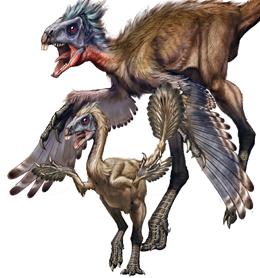 From Nature: Letter Nature 464, 1338-1341 (29 April 2010) Received 18 December 2009; Accepted 24 February 2010 Exceptional dinosaur fossils show ontogenetic development of early feathers Xing Xu1, Xiaoting Zheng2 & Hailu You3 1 - Key Laboratory of Evolutionary Systematics of Vertebrates, Institute of Vertebrate Paleontology & Paleoanthropology, Chinese Academy of Sciences, 142 Xiwai Street, Beijing 100044, China 2 - Shandong Tianyu Museum of Nature, Pingyi, Shandong 273300, China 3 - Institute of Geology, Chinese Academy of Geological Sciences, 26 Baiwanzhuang Road, Beijing 100037, China Recent discoveries of feathered dinosaur specimens have greatly improved our understanding of the origin and early evolution of feathers, but little information is available on the ontogenetic development of early feathers. Here we describe an early-juvenile specimen and a late-juvenile specimen, both referable to the oviraptorosaur Similicaudipteryx, recovered from the Lower Cretaceous Yixian Formation of western Liaoning, China. The two specimens have strikingly different remiges and rectrices, suggesting that a radical morphological change occurred during feather development, as is the case for modern feathers. However, both the remiges and the rectrices are proximally ribbon-like in the younger specimen but fully pennaceous in the older specimen, a pattern not known in any modern bird. In combination with the wide distribution of proximally ribbon-like pennaceous feathers and elongate broad filamentous feathers among extinct theropods, this find suggests that early feathers were developmentally more diverse than modern ones and that some developmental features, and the resultant morphotypes, have been lost in feather evolution. |
Saturday, May 1, 2010
Similicaudipteryx and the evolution of feathers
Subscribe to:
Post Comments (Atom)
No comments:
Post a Comment